When this matchup was drawn, everyone expected the two teams to be on the same level, especially since the first leg between them ended 1-1. So, it was clear that the second leg would be quite thrilling to watch, as most matches in the Europa League and the Champions League are.
One week ago, AZ Alkmaar were the home team and were slightly weaker than LASK Linz, but still, the team of Arne Slot managed to get the draw after the 90 minutes. Both coaches weren’t happy with the performance of their team after the first leg and hoped that their squad would play better in the second game.
In this tactical analysis, we will look at the tactics of both teams and explain how LASK were able to beat Alkmaar with 2-0 as the Austrians reached the round of the last 16 teams in the UEFA Europa League for the first time in the club’s history.
Line-ups
The home side changed nothing compared to the first leg as Alexander Schlager was in goal while the back three of the usual 3-4-3 consisted of Gernot Trauner, Philipp Wiesinger and Petar Filipović. Peter Michorl and James Holland played in central midfield while the full-backs were Reinhold Ranftl and René Renner. The three men upfront were Dominik Frieser, Thomas Goiginger and Marko Raguž.
On the other side, Arne Slot made one change compared to the first game between these two teams, but this one had a huge impact as we will discuss later in this tactical analysis. Fredrik Midtsjö was back after a suspension and replaced Hakon Evjen in central midfield next to Jordy Clasie. The goalkeeper was Marco Bizot. As already seen in the first leg, the three centre-backs Stijn Wuytens, Pantelis Chatzidiakos and Ron Vlaar were all out due to injuries and because of that, Ramon Leeuwin and Teun Koopmeiners (usually defensive midfielder) were in the central defence while the full-backs were the usual ones with Jonas Svensson and Owen Wijndal. In front of the double pivot, Calvin Stengs was the offensive midfielder while the wings were occupied by Dani de Wit and Oussama Idrissi. The single striker was Mayron Boadu.
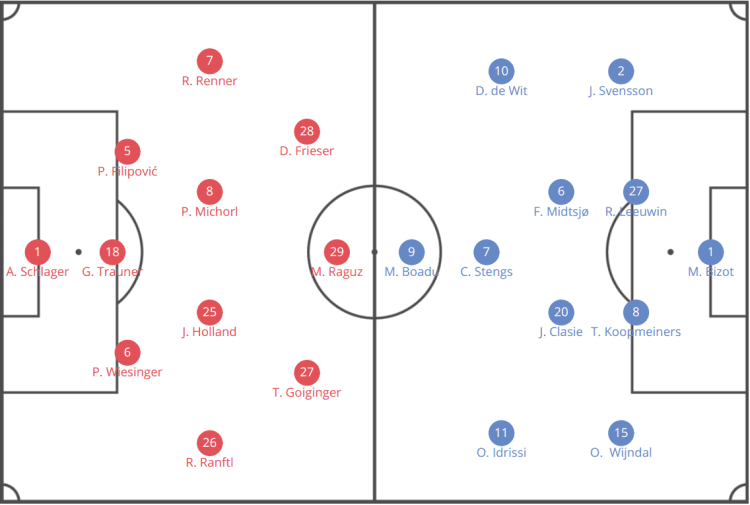
LASK’s usual high press and Alkmaar’s solution
In the first leg, LASK Linz also used a high press and due to that, Alkmaar were almost never able to get out of their own half with the combination of short passes like they usually want to do it. The team of Arne Slot is always looking for a solution with short passes and don’t like to hit the balls long frequently.
In the first game between these two, this rarely worked as LASK’s pressing worked off perfectly and they took Stengs, the most important player of Alkmaar, out of the game. This was possible since Stengs had to play deeper and more central than he usually does since Midtsjö was suspended. So, he had to support Clasie and the back four in several situations during the early stage of the build-up and you clearly saw that this isn’t where he feels comfortable.
Since in this game Midtsjö played next to Clasie in front of the back four, Stengs had the freedom to position himself higher up the pitch in the right half-space. This helped Alkmaar massively during the pressing of LASK which is illustrated below. Again, the three front men were responsible to press the back four of the opposition, but this time Michorl and Holland (the two CMs of LASK) played in a man-orientated manner against the two defensive midfielders of Alkmaar while last time they just had to look after Clasie.
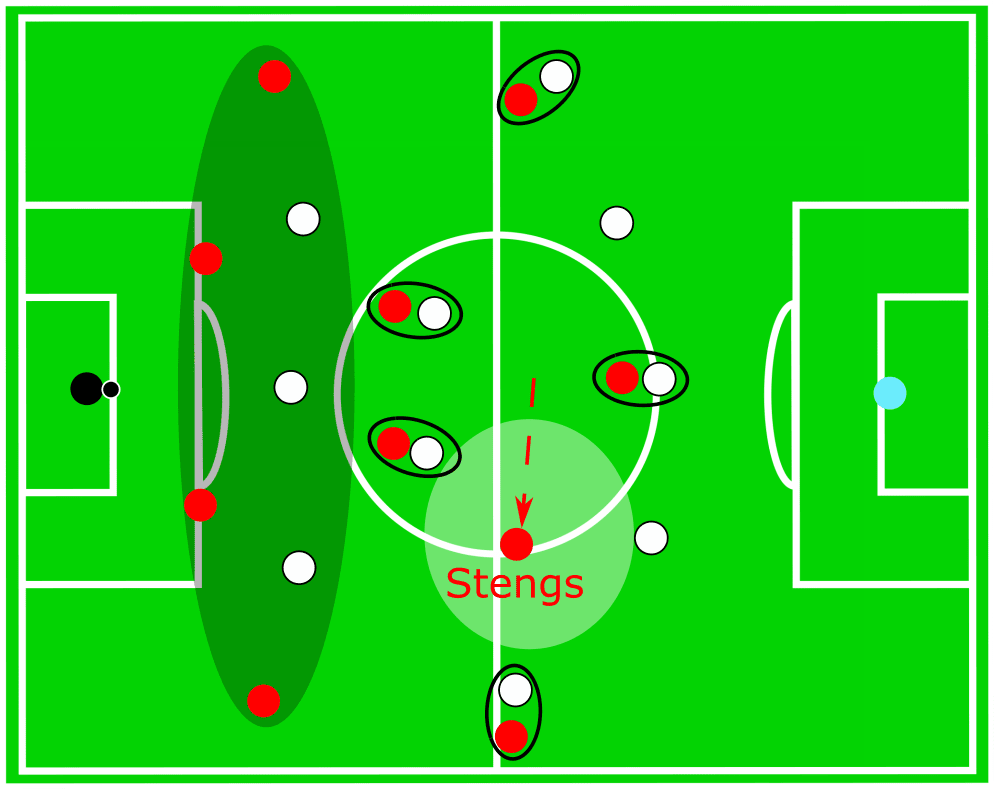
In the image above, we can also see that Clasie and Midtsjö were positioned quite deep during the build-up which led to a higher positioning of LASK Linz’s central midfielders and that created more space for Stengs. Even when Valérien Ismaël’s team dropped deeper and pressed not that high, we always saw how Michorl and Holland man-marked their opponents in the centre.
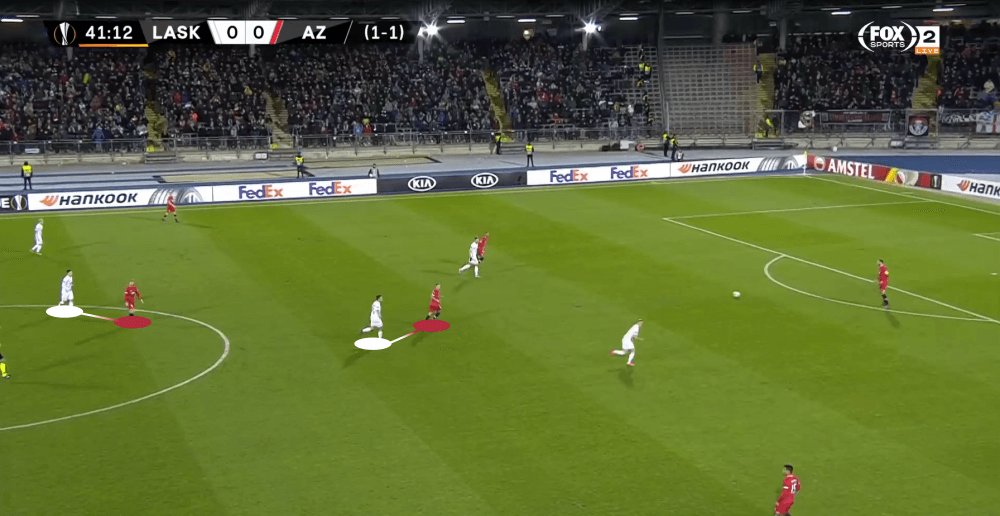
In the first leg, the high and intense pressing of LASK helped them to get control of the game as they never gave their opponents the chance to have a structured and calm build-up. Also, one week ago, the wingers of LASK (Frieser and Goiginger) were positioned a bit wider, so they could press the full-backs of Alkmaar as soon as the ball was played wide to them.
However, in this game, they were positioned more narrowly during the pressing phase to provoke the pass to the full-backs Svensson and Wijndal. Then, the wing-backs of LASK pushed forward to put pressure on them.
But, especially on Linz’s left side, Alkmaar were quite often able to bypass the pressing since firstly, Renner ran forward too late, which gave Svenson enough time to look for a passing option, and secondly, Stengs was primarily positioned in the right half-space and provided his right-back a good passing option in the centre while the double pivot were man-marked. As a third point, De Wit was sometimes free since Renner was logically not able to cut off both passing lanes. So, Stengs’ higher positioning in the right half-space helped Alkmaar massively and this was just possible as Midtsjö was back in the squad. We can see below an example of that as Renner puts pressure on Svensson who could pass the ball to De Wit or to Stengs in the centre. In the end, he plays it to the offensive midfielder who has a lot of free space.
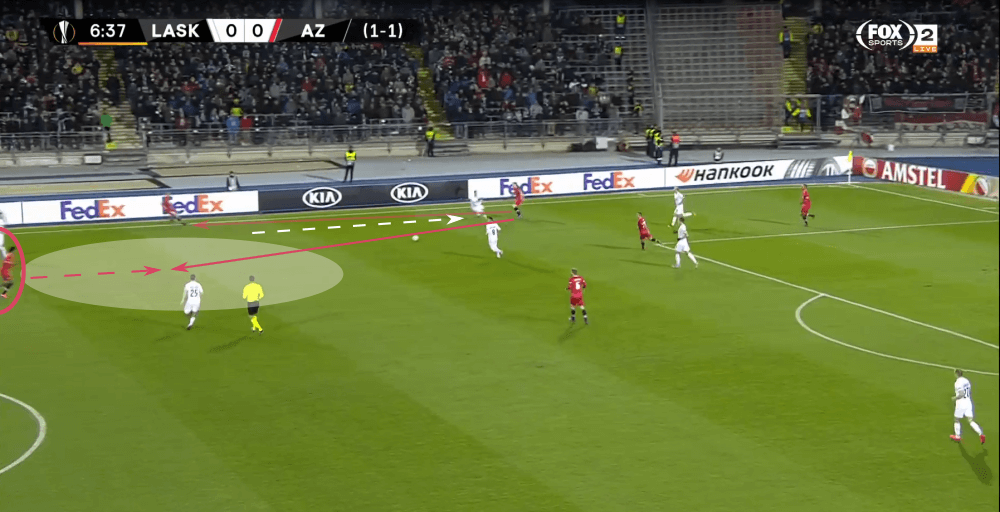
So, they mainly bypassed the press over the right-wing and exploited that Renner pushed forward so late that Svensson could decide to which teammate he would pass. Also, you have to mention that Stengs is great at such moments due to his intelligent movements.
The way how they brought the ball to Svensson was sometimes also quite interesting as they used long balls from the keeper or the left centre-back Koopmeiners several times in order to exploit the free space on the right-wing since all men of LASK shifted towards the ball. This can be seen in the shot below as the goalkeeper finds the right-back with a lobbed ball and this was used several times throughout the game by AZ Alkmaar.
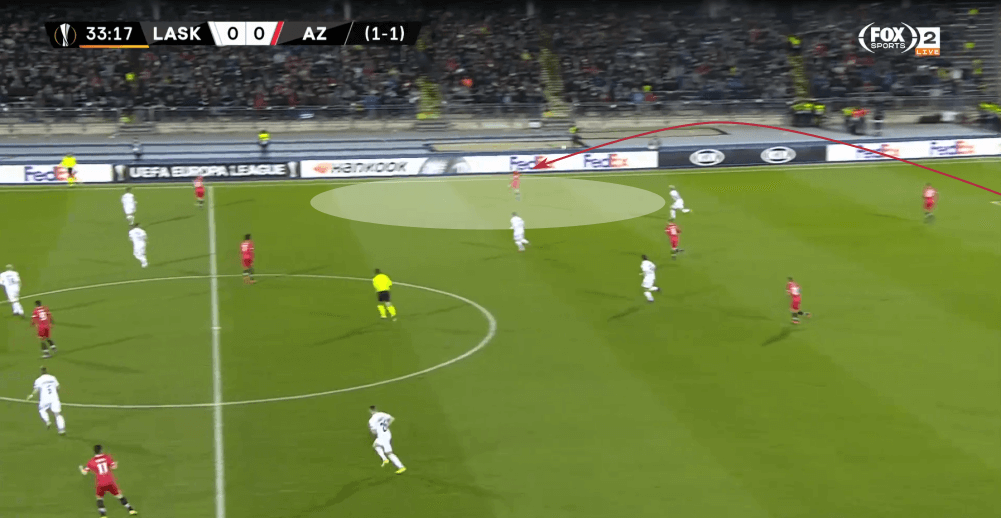
Alkmaar’s ideas in the final third
With De Wit, Stengs, Idrissi and Boadu Alkmaar had four fast offensive players in their squad and wanted to exploit that either after beating the press or during a counter-attack. They did well in both situations but mostly weren’t able to then create really dangerous situations as we’ll see in the next few paragraphs of this tactical analysis.
When Linz attacked and were in the final third, usually Michorl joined his teammates and tried to support them while Holland was a bit deeper and shifted from one side to the other one and tried to intercept passes and avoid counter-attacks. This was a clever tactic as Alkmaar had several quick players up front.
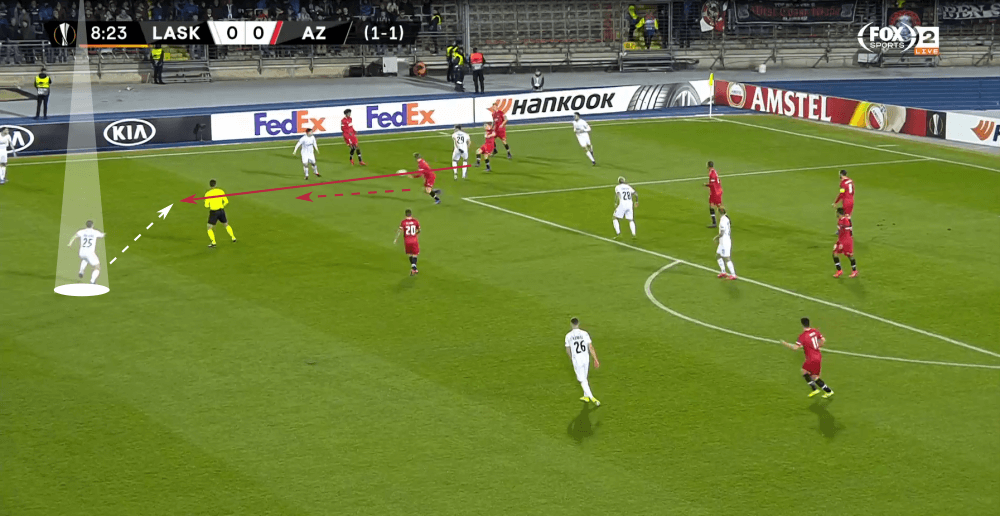
When the team of Slot were able to come past Holland and bypass the counter-pressing of LASK in general, they got exactly where they wanted to as they could force the three defenders of Linz into sprint duels against their attackers. In the image below, we can see a perfect example as there is a lot of space and they can continue the counter-attack with a vertical pass to exploit the quickness of the forwards. Alkmaar were sometimes able to get in such situations after beating the high pressing or counter-pressing of LASK, but were never able to score.
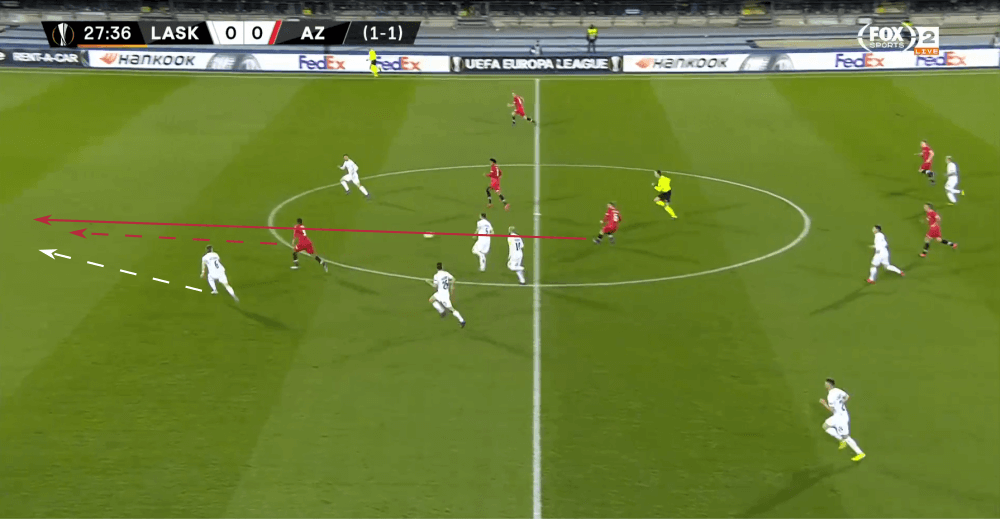
Since LASK Linz didn’t press for the whole 90 minutes, they sometimes sat back deeper and put pressure on the opposition at about the half-way line or even a bit deeper. Alkmaar also had a similar idea in these situations during the build-up as they wanted to switch the sides with long balls to exploit the space on the other wide-area when LASK shifted towards the ball.
This mainly happened from Alkmaar’s left-wing to their right one since there they had Stengs and De Wit while the other wing was mainly occupied just by Idrissi on his own. As already mentioned above in this tactical analysis, Alkmaar were able to get through several times but then either the final pass went wrong or they were too sloppy in front of the goal. These long balls from the left wing to the other one helped them several times to create space for De Wit and Stengs.
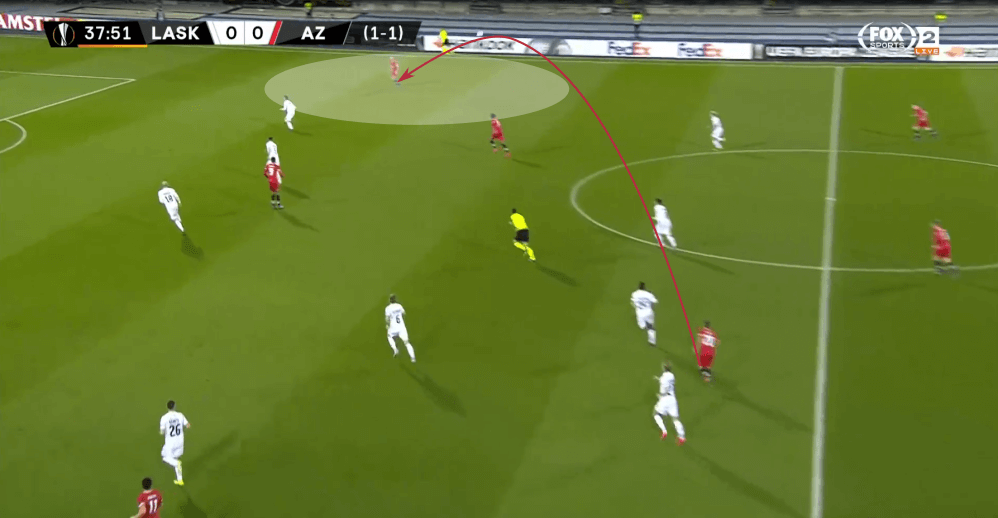
While they used these long balls to create something on the right-wing, in the other wide-area we saw one of their other usual patterns. The left-back Wijndal is famous for his underlapping runs while the winger Idrissi stays wide. In the first leg, they made use of this pattern just one time in the whole game. This time, they were able to show it on a few occasions, but still weren’t able to create something really dangerous with it.
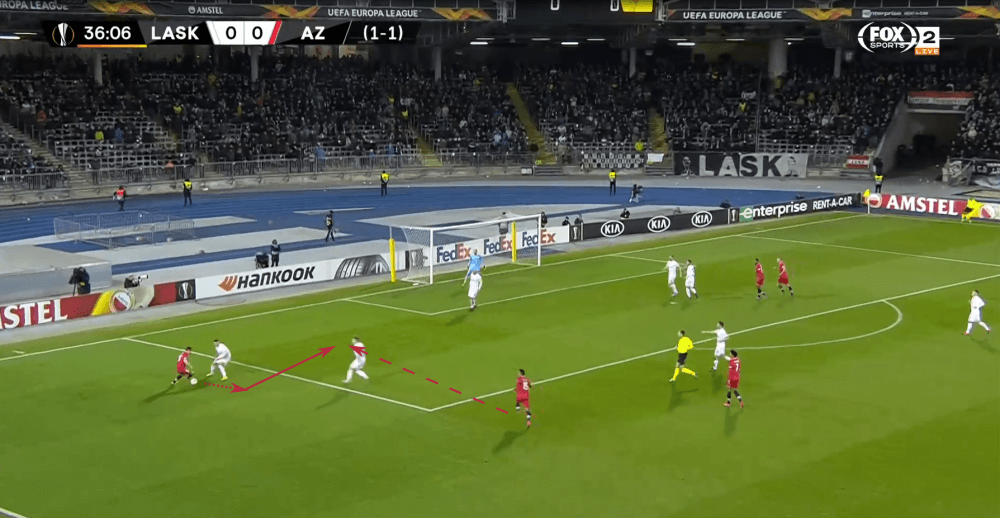
Alkmaar’s defensive approach
But it was not only Alkmaar’s shape during the build-up that changed compared to the first leg and it seemed like they needed that one game to better understand LASK’s style of play. In the first leg they sometimes pressed with three men in the first line, LASK played the usual long balls and Linz had enough bodies in the higher lines to win the second ball to then create something dangerous (especially over the wing).
In this game, AZ Alkmaar’s defensive structure depended on the positioning of LASK’s wing-backs as Idrissi and De Wit followed them. The two central midfielders Clasie and Midtsjö stayed in the space in front of the back four while Stengs joined Boadu to put pressure on LASK with just two men, as we can see in the graphic above. In light of this, it was a 4-4-2 which changed to a 5-3-2 or 6-2-2 depending on the runs of Renner and Ranftl.
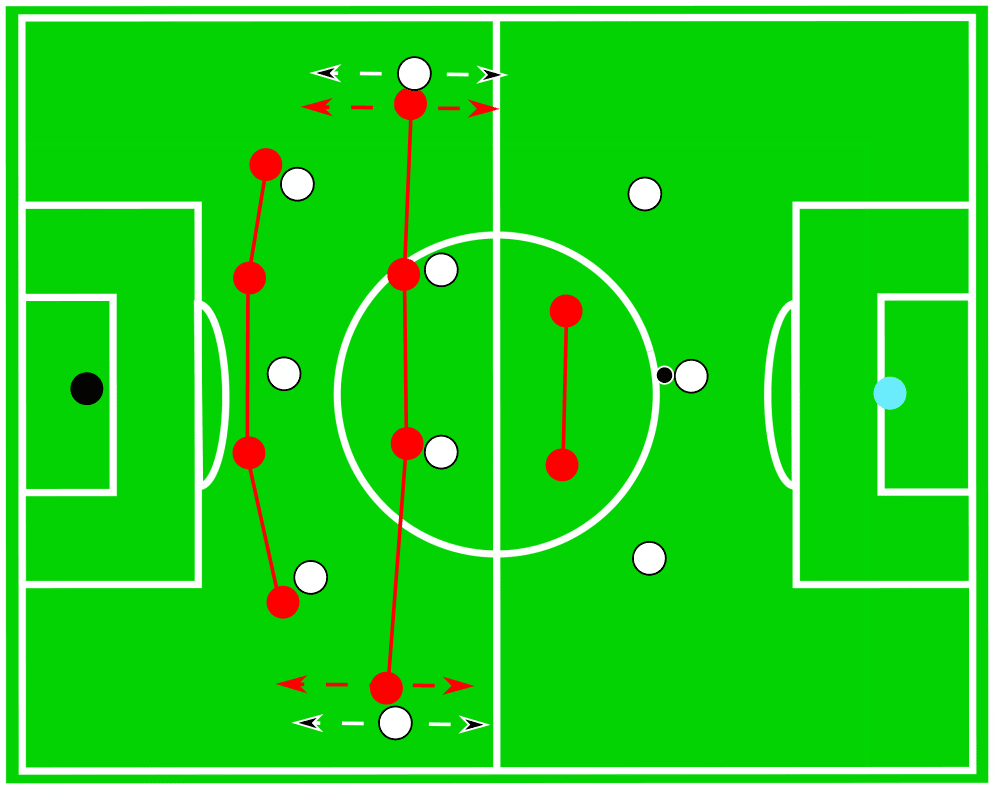
So, the wing-backs of LASK were man-marked – in the middle we had the two central midfielders of each team and upfront Stengs and Boadu were the first ones to press in at LASK’s back three as their pressing height changed throughout the game. Sometimes the whole team pushed forward to put pressure on Trauner, Wiesinger and Filipović deep in the half of Linz while moments later they dropped deeper and started to press at about the half-way line.
Now, we see in the image above that we had a 4-on-3 situation in the centre with LASK’s forwards against the back four of AZ Alkmaar. While the full-backs looked after the wingers and occasionally received support from the centre-back, these two central defenders partnered up to look after Raguž.
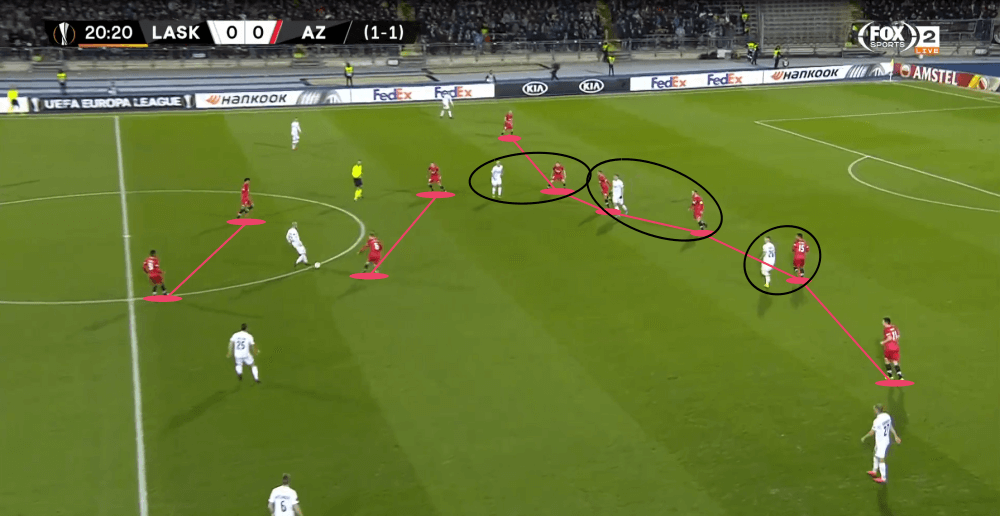
As usual, Raguž was really important as he and the two wingers were the three target men for the long balls. Due to that, they positioned themselves close to each other and tried to either lay the ball off for each other or to have enough bodies in the centre to win back the second ball. Since Raguž is the one with the greatest physical strength, his teammates permanently tried to play the long balls towards him, as we can see in an example below.
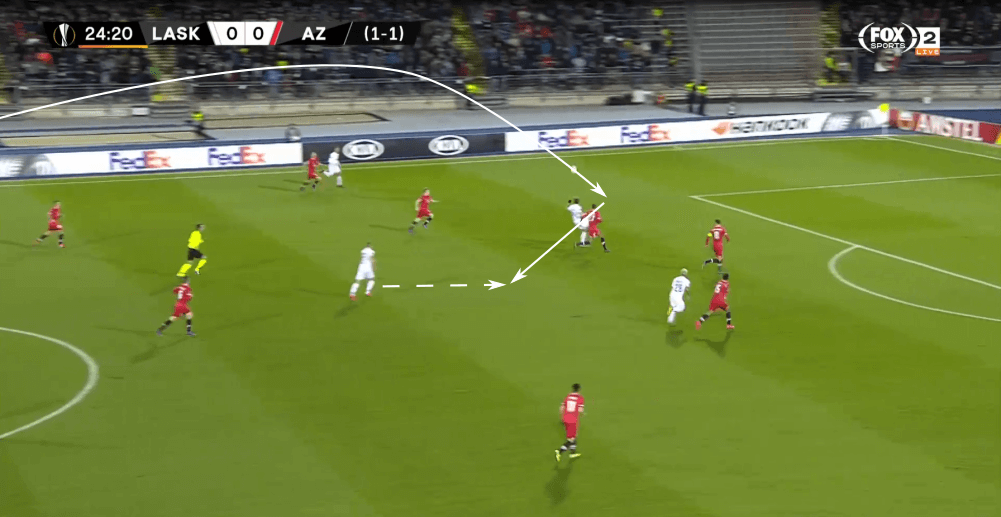
Also, at this point, another one of the typical tactics of LASK Linz came into play as they used an aggressive counter-pressing technique after these long balls, if they weren’t able to win the second ball. As Alkmaar wanted to solve almost all situations with short passes and dribbles, they had huge problems in these situations during the first leg.
However, in this game, they expected LASK to do the same thing and tried to find Stengs who has the technical abilities to stay on the ball under pressure or use long diagonal balls to the wide areas to don’t give LASK even the chance to press in at them. However, this wasn’t always possible and LASK’s counter-pressing worked off once more in several situations, as we can see below.
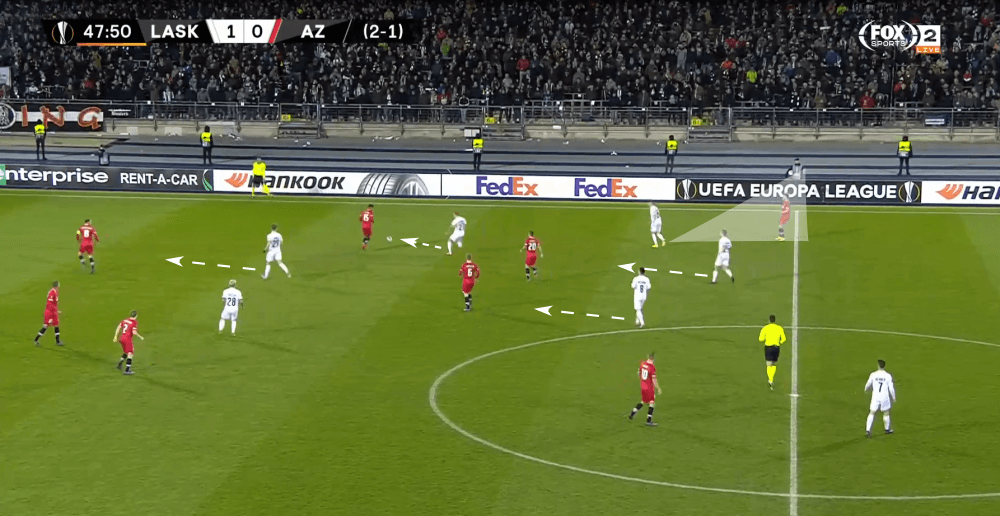
Conclusion
AZ Alkmaar were clearly better compared to the first leg even though the result tells us something different. They had solutions to bypass LASK Linz’s high pressing with which they had huge problems in the first game between them. However, they weren’t effective in the final third at all while Ismaël’s team scored their goals after a throw-in and a penalty kick, which is typical for them.
LASK were able to reach the round of the last 16 teams in the UEFA Europa League (where they will face Manchester United) for the first time in the history of the club, and are currently in the first position in the Austrian Bundesliga and in the semi-final of the ÖFB Cup. So, this season has the potential to be outstanding and we’ll see how the fairytale ends.





Comments